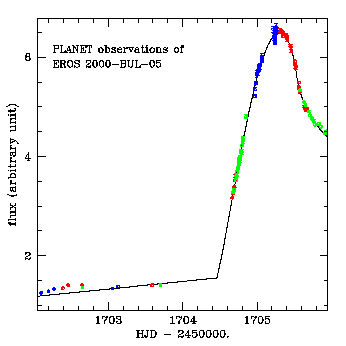
The PLANET collaboration has been performing intense photometric monitoring of the multiple-lens microlensing event EROS BLG-2000-5 from five observing sites distributed in longitude. This event, discovered by the EROS team and first noted to be anomalous by the MPS team, executed a fold caustic crossing at Heliocentric Julian Date (HJD) = 2,451,705.000 +/- 0.002 (see earlier PLANET team electronic alert for the caustic characterization). Due to the early alert of this event and the excellent characterization of its first caustic crossing (see the plot below), we were in an exceptionally favorable situation to predict and monitor the second caustic crossing. Spectroscopic observations of the second crossing may permit the first detailed, spatially-resolved spectrum of any normal star other than the Sun.

PLANET team observations of the first caustic crossing of EROS BUL-2000-05 are shown above. The brightness of the background giant star is shown as a function of time as a caustic from the binary lens passes over it. Each large tick mark is one day. (Red = SAAO 1m in South Africa; Blue = Canopus 1m in Tasmania; Green = CTIO/YALO 1m in Chile.) The line through the points is the model that allowed the parameters of the first caustic to be derived (see below).
Since the time of the first caustic crossing, the source light curve declined and then levelled out in the caustic trough between two caustics. On 21 Jun 2000, PLANET announced in a second electronic alert that data collected from three different PLANET sites within the previous 24 hours all confirmed that the light curve of the source star of EROS 2000-BLG-005 had risen by about 3% over the previous three days.
Subsequent data collected by PLANET confirmed this rise, and frequent updates for the timing of the expected second crossing were posted on this site. Modelling by PLANET indicated that the source would cross the caustic at a small angle and close to a cusp, complicating timing predictions. The second peak in the light curve occured at about HJD=2,451,730.5. From several lines of evidence, PLANET believe that the source star is a K3 III star. Our precaustic models and data indicated that the trailing limb of the star would exist the caustic at HJD = 2,451,733.60 +/- 0.07; a third electronic alert was issued.
The source then exited the caustic structure caused by the multiple foreground lens. On 11 July 2000, we issued a fourth electronic alert that the event was again rising, steeply and perhaps toward a cusp approach or crossing.
PLANET continues to monitor the light curve of EROS BLG-2000-005.
Additional photometric and spectroscopic observations of this second crossing are encouraged. A discussion of how spectroscopic observations of caustics resolve the stellar atmosphere of the source can be found in recent literature (see, for example, Lennon et al. 1996, ApJ, 471, L23; Gaudi & Gould 1999 ApJ, 513, 619; Heyrovsky, Sasselov, & Loeb 2000, ApJ, astro-ph/9902273; and Sackett 2000, astro-ph/0004237, and references therein).
PLANET continues to observe this event.
Event: EROS-2000-BUL-005
RA (J2000): 17:53:11.5
Dec (J2000): -30:55:35
Finding
charts
and future updated information can be found on the PLANET web site at:
http://planet.iap.fr.
EROS information on this event can be found at the EROS alert web page at:
http://www-dapnia.cea.fr/Spp/Experiences/EROS/alertes.html.